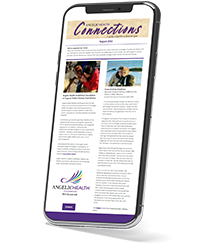Cold Weather Increases Heart Attack Risks Even for Those Without Cardiac Issues

For most of us, cold weather is an inconvenience. We must bundle up, be mindful of slips and slides while walking or driving and clear our pathways. But even without shoveling snow, or a known heart condition, there are those who should be aware that a dip on the thermometer can elevate the risk of heart attacks. Cold temperatures themselves bring unique challenges to heart health. From dressing appropriately to recognizing and responding to symptoms, you can make a significant difference in protecting your heart during the colder months.
Winter risk factors
Several factors increase the likelihood of heart attacks in winter. According to Angelic Health Palliative Care Advance Practice Nurse Patti Newton DNP, RN, APN, FNP-BC, cold temperatures can cause blood vessels to constrict, forcing the heart to work harder. “This can lead to a rise in blood pressure and thickening of the blood, increasing the risk of developing blood clots,” she explained. “Participating in strenuous activities such as shoveling snow makes it even more difficult for the heart to work. Additionally, winter illnesses like the flu can worsen existing heart conditions by intensifying stress on the heart and promoting increased inflammation.” Newton who has been a nurse for over 15 years, mostly as a primary care provider, offers up these tips for a better understanding of winter-related risks is important for taking proactive steps to protect your heart during the winter.
“Cold weather can put anyone at an increased cardiac risk, especially if you don’t regularly exercise. To overexert yourself suddenly in cold weather when you’re not physically fit can be dangerous,” warns Newton. “This is why it’s important to gradually increase your exercise level.”
Preventative measures
Fortunately, there are several things you can do to lower your risk of having a heart attack. These include:
- Dress in layers and wear a hat when outside in the cold, to minimize strain on the heart.
- Stay warm when inside.
- Maintain your regular exercise routine.
- Take all your medications exactly as they’re prescribed.
- Eat mainly vegetables, fruits, and whole grains.
- Limit your intake of alcohol, red meat, sugar, refined carbohydrates, and processed foods.
- Wash your hands frequently to prevent catching viral illnesses.
- Find effective ways to cope with stress.
Recognizing and responding to symptoms
- Pay attention to the most common signs of a heart attack, which are:
- Shortness of breath
- Extreme, sudden fatigue
- Clamminess or sweating
- Pressure, tightness, or pain in your chest, which may be constant, or come and go.
- Numbness, tingling, or pain in your jaw, neck, shoulders, back or arm
- Nausea or vomiting
- Dizziness or lightheaded
Calling 9-1-1 for immediate medical attention is the best thing to do with signs of a possible heart attack in either yourself or someone else. The sooner it’s addressed, the better chance there is of not only survival, but also minimizing the damage done to the heart.
You can significantly reduce the likelihood of a heart attack during the colder months, advises Newton. “By taking preventative measures, maintaining a healthy lifestyle, paying attention to symptoms, and seeking immediate medical attention, you can prioritize your heart health this winter.”
